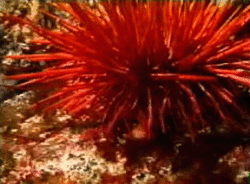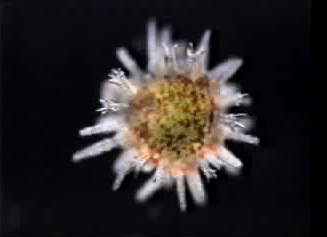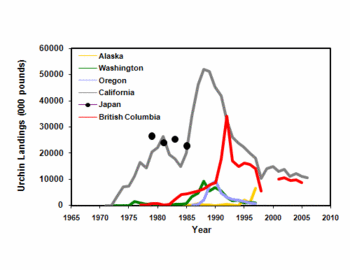Red Sea Urchin: Difference between revisions
imported>Michael Nishizaki |
imported>Michael Nishizaki |
||
| Line 25: | Line 25: | ||
== Feeding Habits == | == Feeding Habits == | ||
As larvae, urchins feed using bands of cilia to capture food particles from the water column<ref name="Strathmann 1971">'''Strathmann, R''' 1971. The feeding behavior of planktotrophic echinoderm larvae: mechanisms, regulation, and rates of suspension feeding. ''Journal of Experimental Marine Biology and Ecology'' 6: 109–160. </ref> while also absorbing amino acids directly from seawater<ref name="Manahan et al. 1983">'''Manahan, D.T., J.P. Davis, & G.C. Stephens''' 1983. Bacteria-free sea urchin larvae: Selective uptake of neutral amino acids from seawater. ''Science'' 220: 204-206. </ref>. After settling on the ocean floor, juveniles begin feeding about 9 days post-metamorphosis. As adults, red urchins feed on a wide range of foods, both plant and animal though | As larvae, urchins feed using bands of cilia to capture food particles from the water column<ref name="Strathmann 1971">'''Strathmann, R''' 1971. The feeding behavior of planktotrophic echinoderm larvae: mechanisms, regulation, and rates of suspension feeding. ''Journal of Experimental Marine Biology and Ecology'' 6: 109–160. </ref>, while also absorbing amino acids directly from seawater<ref name="Manahan et al. 1983">'''Manahan, D.T., J.P. Davis, & G.C. Stephens''' 1983. Bacteria-free sea urchin larvae: Selective uptake of neutral amino acids from seawater. ''Science'' 220: 204-206. </ref>. After settling on the ocean floor, juveniles begin feeding about 9 days post-metamorphosis. As adults, red urchins feed on a wide range of foods, both plant and animal though kelps are the preferred food item. In the Pacific Northwest, urchins preferentially graze [[bull kelp]] (''Nereocystis leutkeana'')<ref name="Vadas 1977">'''Vadas R.L.''' 1977. Preferential feeding: An optimization strategy in sea urchins. ''Ecological Monographs'' 47: 337-371.</ref>, whereas in southern California, ''Macrocystis pyrifera'' is targeted<ref name="Leighton 1966">'''Leighton D.L.''' 1966. Studies of food preference in algivorous invertebrates of Southern California kelp beds. ''Pacific Science'' 20: 104-113.</ref>. | ||
== Behavior and reproduction == | == Behavior and reproduction == | ||
Revision as of 11:48, 31 October 2007
| Red Sea Urchin | ||||||||||||||||||
|---|---|---|---|---|---|---|---|---|---|---|---|---|---|---|---|---|---|---|
 Red Sea Urchin.
(PD) Photo: Michael Nishizaki | ||||||||||||||||||
| Scientific classification | ||||||||||||||||||
| ||||||||||||||||||
| Binomial name | ||||||||||||||||||
| Strongylocentrotus franciscanus (A. Agassiz, 1863) |
The Red Sea Urchin, Strongylocentrotus franciscanus (A. Agassiz, 1863), is a species of marine invertebrate belonging to the phylum Echinodermata or "spiny-skinned" animals. Typically found in the Pacific ocean from Alaska to Baja California, red urchins inhabit shallow waters from the low-tide line to depths of 100 m. In general, this species prefers wave-sheltered rocky shorelines.
Physical Description
During larval development, the body of a sea urchin transitions from radial to bilateral symmetry. This bilaterally symmetrical larva, called an echinopluteus, subsequently develops a type of pentaradiate symmetry that characterises echinoderms. As adults, the body, or test, can reach up to 24 cm and can vary in colour from red to dark burgundy. The test is covered by sharp spines that can grow up to 8 cm. Among the spines are rows of tiny tube feet each terminating with a suction cup. In addition, the body is also covered with small pincer-like structures called pedicellaria.
The mouth of an urchin, called the Aristotle's lantern, consists of 5 teeth and is located on the underside (or oral) of the body. Waste is excreted from an opening on the upper side (or aboral) of the body. During reproduction, eggs and sperm are also released from the aboral side of the body through 5 small openings called gonopores.
Feeding Habits
As larvae, urchins feed using bands of cilia to capture food particles from the water column[1], while also absorbing amino acids directly from seawater[2]. After settling on the ocean floor, juveniles begin feeding about 9 days post-metamorphosis. As adults, red urchins feed on a wide range of foods, both plant and animal though kelps are the preferred food item. In the Pacific Northwest, urchins preferentially graze bull kelp (Nereocystis leutkeana)[3], whereas in southern California, Macrocystis pyrifera is targeted[4].
Behavior and reproduction
Lifespan in red urchins often exceeds 30 years, and recent evidence indicates that some individuals are over 100 years old.[5]. Urchins are known as broadcast spawners, where gametes are released into the water and fertilization occurs in the water column. Spawning peaks between June and September and planktonic larvae (echinopluteus) remain in the water column for about a month before settling on the bottom of the sea floor. Once settled, larvae undergo metamorphosis into juvenile urchins. These juveniles use a set of chemical cues to locate and crawl underneath of near-by adults[6]. Aggregations of adult urchins form a "spine canopy" that provides protection from predation and extreme water motion[7]. It is not surprising then, that juveniles are found almost exclusively sheltering under adults[8] until they reach a test diameter of 40mm[9]. Juveniles are not necessarily related to the adults under which they shelter[10].
Similar species
There are two congeneric species generally found living in the same habitats as the red urchin. The purple urchin, Strongylocentrotus purpuratus is smaller, with shorter spines and a deep purple color. Purple urchins are usually found in slightly shallower and more wave-exposed areas. The second species is the green urchin Strongylocentrotus droebachiensis, which is smaller than the red urchin and has shorter and thinner spines.
Fishery
Red sea urchins are primarily harvested for their reproductive organs, or "roe,". Most sea urchin roe is exported to Japan where it is used as an ingredient in sushi. Harvested in California since the 1970's, sea urchin the fishery and expanded until is was the second most valuable fishery in California.
References
- ↑ Strathmann, R 1971. The feeding behavior of planktotrophic echinoderm larvae: mechanisms, regulation, and rates of suspension feeding. Journal of Experimental Marine Biology and Ecology 6: 109–160.
- ↑ Manahan, D.T., J.P. Davis, & G.C. Stephens 1983. Bacteria-free sea urchin larvae: Selective uptake of neutral amino acids from seawater. Science 220: 204-206.
- ↑ Vadas R.L. 1977. Preferential feeding: An optimization strategy in sea urchins. Ecological Monographs 47: 337-371.
- ↑ Leighton D.L. 1966. Studies of food preference in algivorous invertebrates of Southern California kelp beds. Pacific Science 20: 104-113.
- ↑ Ebert, TA and JR Southon 2003. Red sea urchins can live over 100 years: confirmation with A-bomb [14.sup]carbon - Strongylocentrotus franciscanus. Fishery Bulletin, 101(4): 915-922.
- ↑ Nishizaki, MT & JD Ackerman 2005. A secondary chemical cue facilitates adult-juvenile associations in red sea urchins (Strongylocentrotus franciscanus). Limnology & Oceanography 50(1): 354-362.
- ↑ Nishizaki MT and JD Ackerman 2007. Juvenile–adult associations in sea urchins (Strongylocentrotus franciscanus and S. droebachiensis): protection from predation and hydrodynamics in S. franciscanus). Marine Biology 151:135-145.
- ↑ Low, CG 1975. The effect of grouping of Strongylocentrotus franciscanus, the giant red sea urchin, on its population biology. Ph.D. thesis, University of British Columbia, Vancouver, BC.
- ↑ Tegner MJ and PK Dayton 1977. Sea urchin recruitment patterns and implications of commercial fishing. Science 196: 324-32.
- ↑ Moberg, PE & RS Burton 2000. Genetic heterogeneity among recruit and adult red sea urchins, Strongylocentrotus franciscanus. Marine Biology 136:773-784.

